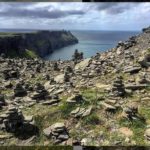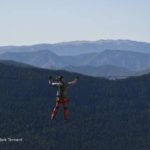A clear sky greeted me as I opened the curtains on Wednesday morning.? The drive to Pralognan-la-Vanoise via Bozel was pleasant with the early signs of spring.? Soon the road started to climb in a series of zig-zags and eventually I reached Pralogan and the meeting point with Finn and his son, the Hotel Grand Bec.
After sorting out snowshoes and poles we walked the short distance through the village to the ski lift office.? We took passes for two of the chairlifts that save 500m of climbing and reach the Refuge des Barmettes at the entrance to the Vanoise National Park.? The vista as we rode the lifts was stunning with clear blue skies the back drop to the peaks including the Grande Casse and the Aiguille de la Vanoise.? Arriving at the top it was time to put on snowshoes and sort out some other equipment.? A short walk took us across a bridge and the start of the ancient route du sel, currently well buried under the winter snows.? Just at this point I caught a glimpse of one of the Vanoise’s resident “Bearded Vultures” (Gypaete Barbu) with it’s 2m 80m wingspan gliding effortlessly along the cliffs to our left.? We stopped to enjoy this spectacle as it searched for carcasses released from winter’s grip or those unfortunate animals to have been caught by an avalanche.
We reached the Lac des Vaches buried under the snow and ice under the shadows of the Aiguille de la Vanoise.? A respite from the steady climb and we could see the glacier of the Grand Couloir on the Grande Casse.? I wondered if there was anyone skiing it.? A final climb lead to where the path turns to pass above Lac Long and in about an hour we arrived at the Refuge Felix-Faure (Col de la Vanoise).? The refuge was open to cater for the ski touring / mountaineering and we went into the warmth of the hut.? We enjoyed some hot soup and for Finn and his son a filling omellette.
The return journey saw us take a “short-cut” under the Aiguille de la Vanoise which enabled us to find some cold powedery snow; much nicer to descend.? Eventually we reached the flat bottom of the valley and the stream.? Here we wander along it’s banks and saw ibex on the grassy shelves on the cliffs above.? Finally back at the chairlift for an easy descent to the valley.? A brilliant day.



